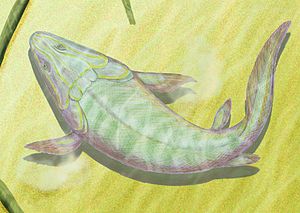Panderichthys
| Panderichthys | ||||||||||||
|---|---|---|---|---|---|---|---|---|---|---|---|---|

Life picture of Panderichthys rhombolepsis |
||||||||||||
| Temporal occurrence | ||||||||||||
| Upper Devonian | ||||||||||||
| 383.7 to 376.1 million years | ||||||||||||
| Locations | ||||||||||||
| Systematics | ||||||||||||
|
||||||||||||
| Scientific name | ||||||||||||
| Panderichthys | ||||||||||||
| Gross , 1941 |
Panderichthys is an approximately 380 million year old genus of fossil fish from the Upper Devonian , which is also known as the primeval coelacanth . So far, Panderichthys rhombolepsis is the only known species . Named is Panderichthys after the German Baltic palaeontologist Christian Heinrich Pander described the numerous spätpaläozoische fish.
Anatomical details
Fins
Panderichthys is interpreted as a transitional form between fish and primitive terrestrial vertebrates (Tetrapoda), since the bones of its front pectoral fins were already largely transformed into limbs , while the rear pelvic fins were still largely fish-like. From the change in the bones of the forelegs and their anchoring on the trunk, it was also concluded that the animal's muscles were also able to support the body at least temporarily. This transition from fins to legs is considered to be one of the most important changes that enabled vertebrates to go ashore .
The movement of the animal on the ground was described by a researcher at Uppsala University as "snaking", whereby the animal may have used its front extremities to hold on to the ground.
In an in Tallinn custody, specimen (VSN GIT 434-1) were almost perfectly preserved in 2008 with the help of a computer tomography (CT) Details of the fins investigated. It turned out that earlier investigations had been flawed, as the result of which flat bone structures in the area of the fins had been described. From this it was concluded at the time that the bones of the fingers and toes developed later - in the terrestrial vertebrates - and were not already laid out in the skeleton of the fish. In the CT images that were now created, however, there were clearly numerous bones in the fins of Panderichthys , which were interpreted as forerunners of the finger and toe bones that developed from them.
Breathing holes
What is also remarkable about this fossil are the two greatly enlarged injection holes (breathing holes) in the area of the gills . The research group from Uppsala interpreted these openings in the journal Nature as the openings from which the auditory canals of terrestrial vertebrates later developed, especially the middle ear . According to their investigations, the shape of the bones on the head of Panderichthys show characteristics of both fish and terrestrial vertebrates. In the prehistoric Panderichthys , however, the breathing holes were clearly used to take in water and may have been expanded in the course of the species’s tribal history because the animal often lay dormant on the ground. In the further course of the tribal history of these vertebrates, this bone canal, which is primarily used for underwater breathing , was possibly later used for air breathing and later closed with a skin from which the eardrum emerged .
The findings were made on a specimen from the Latvian Museum of Natural History in Riga and, according to the authors, provide further evidence that even complex organs such as the ear canal have evolved from simple precursor stages through the process of evolution . In Nature , this change was so pointed in a comment: “ Our ears once breathed. "(German:" Our ears once breathed. ")
See also
Individual evidence
- ^ Catherine A. Boisvert: The pelvic fin and girdle of Panderichthys and the origin of tetrapod locomotion. In: Nature . Volume 438, 2005, pp. 1145-1147, doi: 10.1038 / nature04119
- ^ Catherine A. Boisvert, Elga Mark-Kurik and Per E. Ahlberg: The pectoral fin of Panderichthys and the origin of digits. In: Nature. Volume 456, 2008, pp. 636-638; doi: 10.1038 / nature07339
- ^ Martin D. Brazeau, Per E. Ahlberg: Tetrapod-like middle ear architecture in a Devonian fish. In: Nature. Volume 439, 2006, pp. 318-321, doi: 10.1038 / nature04196
- ↑ Helen Pearson: Our ears once breathed. Fossil evidence points to the origin of hearing apparatus. In: Nature. Online publication from January 18, 2006, doi: 10.1038 / news060116-8
